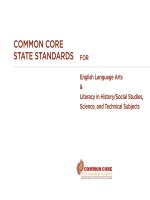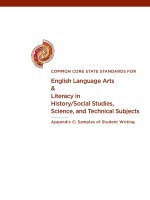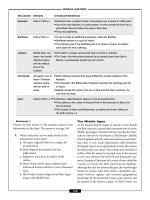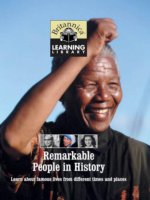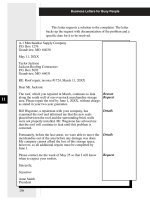Remarkable People in History pot
Bạn đang xem bản rút gọn của tài liệu. Xem và tải ngay bản đầy đủ của tài liệu tại đây (3.78 MB, 66 trang )
Remarkable People
in History
Learn about famous lives from
different times and places
CHICAGO LONDON NEW DELHI PARIS SEOUL SYDNEY TAIPEI TOKYO
LEARNING
LIBRARY
B
r
i
t
a
n
n
i
c
a
®
© 2008 BY ENCYCLOPÆDIA BRITANNICA,INC.
Cover photos (front): Brooks Kraft/Corbis Sygma; (back): Kennan Ward/Corbis. Cover insert photos (left): Bettmann/Corbis; (center): Gavin Wickham—Eye
Ubiquitous/Corbis; (right): Anne Frank House, Amsterdam and Anne Frank-Fonds, Basel—Hulton/Archive by Getty Images
International Standard Book Number:978-1-59339-510-0
No part of this work may be reproduced or utilized in any form or by any means, electronic or mechanical, including photocopying, recording, or by any
information storage and retrieval system, without permission in writing from the publisher.
BRITANNICA LEARNING LIBRARY:REMARKABLE PEOPLE IN HISTORY 2008
Britannica.com may be accessed on the Internet at .
(Trademark Reg. U.S. Pat. Off.) Printed in U.S.A.
PROJECT TEAM
Judith West, Editorial Project Manager
Christopher Eaton, Editor and Educational
Consultant
Kathryn Harper, U.K. Editorial Consultant
Marilyn L. Barton, Senior Production
Coordinator
Editors
Theodore Pappas
Anthony L. Green
Mary Rose McCudden
Andrea R. Field
Michael J. Anderson
Colin Murphy
Locke Petersheim
Indu Ramchandani (Encyclopædia
Britannica India)
Bhavana Nair (India)
Rashi Jain (India)
Design and Media Specialists
Nancy Donohue Canfield, Design
Megan Newton-Abrams, Design
Karen Koblik, Photos
Joseph Taylor, Illustrations
Amy Ning, Illustrations
Jerry A. Kraus, Illustrations
Michael Nutter, Maps
Copy Editors
Barbara Whitney
Laura R. Gabler
Dennis Skord
Lisa Braucher, Data Editor
Paul Cranmer, Indexer
ENCYCLOPÆDIA BRITANNICA
PROJECT SUPPORT TEAM
EDITORIAL
Linda Berris
Robert Curley
Brian Duignan
Kathleen Kuiper
Kenneth Pletcher
Jeffrey Wallenfeldt
Anita Wolff
Charles Cegielski
Mark Domke
Michael Frassetto
James Hennelly
Sherman Hollar
Michael R. Hynes
Sandra Langeneckert
Gene O. Larson
Michael I. Levy
Robert Lewis
Tom Michael
Janet Moredock
DESIGN
Steven N. Kapusta
Carol A. Gaines
Cate Nichols
ART
Kathy Nakamura
Kristine A. Strom
Nadia C. Venegas
ILLUSTRATION
David Alexovich
Christine McCabe
Thomas Spanos
MEDIA ASSET MANAGEMENT
Jeannine Deubel
Kimberly L. Cleary
Kurt Heintz
Quanah Humphreys
COPY
Sylvia Wallace
Jennifer F. Gierat
Glenn Jenne
Mary Kasprzak
Thad King
Larry Kowalski
Joan Lackowski
Dawn McHugh
Julian Ronning
Chrystal Schmit
Sarah Waterman
INFORMATION MANAGEMENT/
INDEXING
Carmen-Maria Hetrea
Edward Paul Moragne
Marco Sampaolo
Sheila Vasich
Mansur G. Abdullah
Keith DeWeese
Catherine Keich
Stephen Seddon
EDITORIAL TECHNOLOGIES
Steven Bosco
Gavin Chiu
Bruce Walters
Mark Wiechec
COMPOSITION TECHNOLOGY
Mel Stagner
MANUFACTURING
Dennis Flaherty
Kim Gerber
INTERNATIONAL BUSINESS
Leah Mansoor
Isabella Saccà
ENCYCLOPÆDIA BRITANNICA, INC.
Jacob E. Safra,
Chairman of the Board
Jorge Aguilar-Cauz,
President
Michael Ross,
Senior Vice President, Corporate Development
Dale H. Hoiberg,
Senior Vice President and Editor
Marsha Mackenzie,
Managing Editor and Director of Production
In
Remarkable
People in
History
, you’ll
discover answers to these
questions and many more.
Through pictures, articles,
and fun facts, you’ll learn
about extraordinary people
who have changed the
course of history.
INTRODUCTION
Who is known as the Father of Europe? What did Tenzing Norgay climb?
How did Cleopatra die? Why did Gandhi march to the sea?
Remarkable People in History
To help you on your journey, we’ve provided the following guideposts in
Remarkable People in History
:
■ Subject Tabs—The colored box in the upper corner of each right-hand
page will quickly tell you the article subject.
■ Search Lights—Try these mini-quizzes before and after you read the
article and see how much—and how quickly—you can learn. You can even
make this a game with a reading partner. (Answers are upside down at the
bottom of one of the pages.)
■ Did You Know?—Check out these fun facts about the article subject.
With these surprising
“
factoids,” you can entertain your friends, impress
your teachers, and amaze your parents.
■ Picture Captions—Read the captions that go with the photos. They
provide useful information about the article subject.
■ Vocabulary—New or difficult words are in bold type. You’ll find
them explained in the Glossary at the end of the book.
■ Learn More!—Follow these pointers to related articles in the book. These
articles are listed in the Table of Contents and appear on the Subject Tabs.
LEARNING
LIBRARY
B
r
i
t
a
n
n
i
c
a
®
Have a great trip!
© 2008 Encyclopædia Britannica, Inc.
Cathy Freeman was the first Aboriginal to win an
individual medal in an Olympic event. She won the 400-
meter race at the 2000 Olympics in Sydney, Australia.
© Duomo/Corbis
© 2008 Encyclopædia Britannica, Inc.
Remarkable People in History
TABLE OF CONTENTS
INTRODUCTION . . . . . . . . . . . . . . . . . . . . . . . . . . . . . 3
LEADERS AND EMPIRE BUILDERS
Ashoka: The Emperor and the Right Way of Living . . 6
Julius Caesar: Rome’s Remarkable
General and Statesman . . . . . . . . . . . . . . . . . . . . . 8
Fidel Castro: The Man Who Changed Cuba . . . . . . . . 10
Charlemagne: The Father of Europe. . . . . . . . . . . . . 12
Cleopatra: Queen of Egypt . . . . . . . . . . . . . . . . . . . . 14
Elizabeth I: A Clever, Courageous Queen. . . . . . . . . . 16
Empress of China: The Dragon Empress . . . . . . . . . 18
Mohammed Ali Jinnah: Founder of Pakistan . . . . . . 20
Nelson Mandela: A Fighter for Rights . . . . . . . . . . . 22
Mao Zedong: Architect of Modern China . . . . . . . . . . 24
Golda Meir: Israel’s First Woman Prime Minister. . . 26
Anwar el-Sadat: Egypt’s Man of Peace. . . . . . . . . . . 28
U Thant: World Peacemaker. . . . . . . . . . . . . . . . . . . 30
HEROES AND DISCOVERERS
Anne Frank: A Young Girl and Her Diary . . . . . . . . . 32
Simón Bolívar: Hero of Many Nations. . . . . . . . . . . . 34
Mahatma Gandhi: Salt and Empires . . . . . . . . . . . . 36
Martin Luther King, Jr.: Civil Rights Leader . . . . . . . 38
Ferdinand Magellan: Around-the-World Voyager . . . 40
Tenzing Norgay: On Top of the World . . . . . . . . . . . . 42
Mother Teresa: Mother of the Poor and Dying. . . . . . 44
ARTISTS, ATHLETES, AND SCIENTISTS
Elizabeth Blackwell: The First
Modern Woman Doctor . . . . . . . . . . . . . . . . . . . . . 46
Cathy Freeman: Gold Medalist in Track . . . . . . . . . . 48
Galileo Galilei: The Man Who Discovered
Outer Space . . . . . . . . . . . . . . . . . . . . . . . . . . . . . 50
Jane Goodall: The Woman Who Lived
with Chimpanzees . . . . . . . . . . . . . . . . . . . . . . . . 52
Helen Keller: Woman of Courage . . . . . . . . . . . . . . . 54
Louis Pasteur: The Man Who Conquered Disease . . . 56
Pelé: Football Star . . . . . . . . . . . . . . . . . . . . . . . . . . 58
William Shakespeare: Plays That Never Grow Old . . 60
GLOSSARY . . . . . . . . . . . . . . . . . . . . . . . . . . . . . . . 62
INDEX . . . . . . . . . . . . . . . . . . . . . . . . . . . . . . . . . . . 63
LEARNING
LIBRARY
B
r
i
t
a
n
n
i
c
a
®
© 2008 Encyclopædia Britannica, Inc.
6
Some 2,200 years ago, the emperor Ashoka ruled India.
Like many ancient rulers, he expanded his empire by
conquering new lands. But unlike most rulers, Ashoka
suddenly turned his back on warfare and began to govern
according to the nonviolent beliefs of Buddhism.
It is said that Ashoka became a Buddhist when he saw the
horrors caused by the wars he’d led. After that, he decided to
serve his subjects and all humanity instead of conquering
others. He called this “conquest by dharma.” In India
dharma means the “right way of living” and “universal
truth.” This included being honest, truthful, and kind. It
also meant being merciful, generous, and thoughtful.
The emperor himself would often tour the countryside, preaching his
belief in dharma to the people. Ashoka also appointed “dharma ministers”
to help relieve people’s sufferings. These ministers were assigned to look
after the special needs of women and people living in religious communities.
Ashoka passed laws to prevent cruelty to animals and had hospitals
built for both people and animals. He also started construction projects to
make all people’s lives easier. Trees were planted on roadsides, wells were
dug, and watering sheds and rest houses were built.
The only recognition Ashoka wanted was for people to remember that
he had ruled according to dharma. To preserve his ideas, Ashoka had his
teachings carved on rocks and pillars (columns) in public areas. These
inscriptions are called the Rock Edicts and Pillar Edicts. The most famous is
the lion pillar found at Sarnath, which has become India’s national emblem.
L
EARN MORE! READ THESE ARTICLES…
JULIUS CAESAR • CHARLEMAGNE
MAHATMA GANDHI
T
h
e
E
m
p
e
r
o
r
a
n
d
t
h
e
R
i
g
h
t
W
a
y
o
f
L
i
v
i
n
g
Ashoka
was an
Indian
a) mathematician.
b) emperor.
c) priest.
S
E
A
R
C
H
L
I
G
H
T
Sarnath, an archaeological site in northern India, is
said to be the place where the Buddha first preached
to his followers. Ashoka built this stupa (shrine) and
others, as well as pillars, to honor the event.
© Brian A. Vikander/Corbis
DID YOU KNOW?
Despite his reputation as a kind and
generous ruler, some stories describe
Ashoka as cruel and ruthless.
According to one story, he had all his
brothers killed in order to seize the
throne.
© 2008 Encyclopædia Britannica, Inc.
ASHOKA
Answer: b) emperor.
★
© 2008 Encyclopædia Britannica, Inc.
DID YOU KNOW?
In William Shakespeare’s play
Julius
Caesar
, Caesar is told to “beware the
ides of March.” The ides refers to the
time around the 15th of the month.
Today those famous words are
sometimes used as a warning.
© 2008 Encyclopædia Britannica, Inc.
JULIUS CAESAR
9
Julius Caesar was a brilliant general and a gifted writer. But most
important, he helped create the ancient Roman Empire.
Early in his career Caesar formed a bond with the two most powerful
men in Rome, the wealthy Crassus and the general Pompey. In 59 BC they
helped elect Caesar as one of Rome’s two consuls,
the government’s highest rank. After a year as
consul, Caesar left Rome to govern Gaul (now
France). There he earned a reputation as a military
leader. He stopped uprisings and invasions, and he
even landed in Britain. Caesar also wrote detailed
accounts of his battles.
While Caesar was in Gaul, Crassus was killed.
Pompey now controlled Rome, and he turned against
Caesar. He declared Caesar a criminal and ordered
him to break up his army. Instead, Caesar declared
war and marched to Rome. Pompey fled to Greece.
At that time Rome was governed by a senate (a
supreme council). But Caesar felt the government was corrupt and needed
a strong leader. In 49 BC he declared himself dictator, and he spent five
years fighting a civil war against Pompey to make his rule secure. Some
of the Roman senators worried that Caesar had too much power. On
March 15, 44 BC, they murdered Caesar on the floor of the Senate.
In the short time he led Rome, Caesar proved to be a great
statesman. The changes he made helped begin the 500-year Roman
Empire. And for almost 2,000 years after his death, some world
leaders used a form of the title “caesar” (such as “Kaiser” in Germany
and “czar” in Russia).
L
EARN MORE! READ THESE ARTICLES…
ASHOKA • CHARLEMAGNE • CLEOPATRA
Answer: Caesar took power in Rome after defeating Pompey, his
former political supporter.
★
G
e
n
e
r
a
l
a
n
d
S
t
a
t
e
s
m
a
n
R
o
m
e
’
s
R
e
m
a
r
k
a
b
l
e
By crossing over the stream known as the Rubicon in 49 BC, Caesar
basically declared war against the Roman Senate. “Crossing the
Rubicon,” the subject of this engraving, became a phrase that
means taking a step from which there’s no turning back.
© Bettmann/Corbis
Sculpture of Julius Caesar, in the
National Museum in Naples.
© Bettmann/Corbis
Fill in
the blank:
Caesar took
power in Rome
after defeating
___________,
his former
political supporter.
S
E
A
R
C
H
L
I
G
H
T
© 2008 Encyclopædia Britannica, Inc.
DID YOU KNOW?
Castro was a very good baseball
player. It is said he once even tried
out for the Senators, a professional
baseball team in Washington, D.C.
10
© 2008 Encyclopædia Britannica, Inc.
Fidel Castro often spoke out strongly against people
who disagreed with his communist government in
Cuba. Here he speaks at a rally in 2003.
© AFP/Corbis
FIDEL CASTRO
11
In the 1950s General Fulgencio Batista ruled the Caribbean
island of Cuba
. His rule was harsh and often violent, and some
large American companies grew rich while many Cubans
remained poor. Fidel Castro was a young lawyer who believed
Batista’s rule was unfair. There were no free elections in Cuba, so
Castro organized a military force to overthrow Batista.
Castro bought guns with his own money and attacked Batista’s
forces in 1953. The attack failed badly, and after two years in
prison Castro went to Mexico to make a new plan. Soon he and
about 80 other rebels arrived in Cuba. They hid in the mountains
and fought a guerrilla war using small-scale battles and making
hit-and-run attacks. Batista finally fled Cuba in 1959.
Castro became Cuba’s leader and created a communist government. In
some ways the lives of the people did not
improve under Castro’s rule. The people lost
many of the same rights that Batista had taken
away, and poverty was still a problem. Many
Cubans left their homeland or tried to do so.
But Castro also greatly increased many benefits
to the Cuban people. Education and health
services were free, and every citizen was
guaranteed work.
The United States, Cuba’s near neighbor,
strongly opposed Castro’s government. They
even tried to overthrow it in 1961. But the Soviet Union, another
communist country, supported Castro. The United States complained when
Castro let the Soviets set up nuclear weapons in Cuba. The protest almost
led to a war, but the weapons were soon removed. In the late 20th century
there was unrest among Cubans, and Castro relaxed some of his strictest
controls. Still, Castro remained Cuba’s powerful leader for many years.
L
EARN MORE! READ THESE ARTICLES…
SIMÓN BOLÍVAR • NELSON MANDELA • MAO ZEDONG
Answer: FALSE. Since the early 1960s, the United States has
opposed Castro and has supported attempts to overthrow him.
★
Fidel Castro in 1960.
© Bettmann/Corbis
True
or false?
The United
States has also
supported Castro’s
rule in Cuba.
S
E
A
R
C
H
L
I
G
H
T
C
h
a
n
g
e
d
C
u
b
a
T
h
e
M
a
n
W
h
o
© 2008 Encyclopædia Britannica, Inc.
DID YOU KNOW?
Charlemagne enjoyed swimming. He
even built a palace on a hot spring
that he used for bathing with friends.
Charlemagne’s empire
survived for only a brief time
after he died. But no other
ruler in the European Middle
Ages had such a deep and
long-lasting effect.
© Ali Meyer/Corbis
12
© 2008 Encyclopædia Britannica, Inc.
CHARLEMAGNE
13
During the Middle Ages (about AD 500-1500) one of the most
powerful European kings was Charlemagne. Charlemagne was a
Frank. The Franks were a people who lived in parts of what are
now France and Germany. When he became the one and only
ruler
of the Frankish lands in AD 771, Charlemagne wanted to make his
kingdom bigger and stronger. He also wanted to spread
Christianity and protect the Roman Catholic church.
With this plan in mind, Charlemagne spent 30 years battling
the Saxons, another Germanic people. In these and many other
wars, Charlemagne gained control over much of western
Europe, including what is now France, Switzerland, Belgium,
the Netherlands, and half of Italy and Germany.
In 794 Charlemagne established his capital at Aachen in western
Germany. In the year 800, the pope
crowned him emperor of the whole region.
He worked with leaders of the church to
improve the church and government. And
he sent out special agents to make sure
that his laws were being obeyed.
Charlemagne brought about many
improvements in the empire. He set up a
new money system and reformed the law
courts. He built a large court library and
set up a school at his palace court. He was
concerned with educating the ordinary people and improving the learning
of priests. He hoped education would make his people better Christians.
Charlemagne died in 814. Today he is remembered as one of the most
important rulers in European history. In fact, he’s sometimes called the
father of Europe.
L
EARN MORE! READ THESE ARTICLES…
ASHOKA • JULIUS CAESAR • EMPRESS OF CHINA
Answer: a) pyramids
★
Which of
these did
Charlemagne
not build?
a) pyramids
b) schools
c) libraries
S
E
A
R
C
H
L
I
G
H
T
Illuminated (richly decorated) manuscript showing
Charlemagne meeting Pope Adrian I.
© Archivo Iconografico, S.A./Corbis
T
h
e
F
a
t
h
e
r
o
f
E
u
r
o
p
e
© 2008 Encyclopædia Britannica, Inc.
14
© 2008 Encyclopædia Britannica, Inc.
CLEOPATRA
15
Answer: Cleopatra ruled Egypt twice.
★
She spoke nine languages, was a good mathematician, and had
a great head for business. And she would use both her intelligence
and her beauty to hold on to power. Today, Cleopatra VII Thea
Philopator of Egypt is still an amazing historical figure.
Cleopatra was the second daughter of King Ptolemy XII. When
her father died in 51 BC, 18-year-old Cleopatra was supposed to rule
Egypt with her 15-year-old brother, Ptolemy XIII. In a few years,
her brother’s supporters drove Cleopatra from power. But later the
Roman leader Julius Caesar helped her get her throne back. War
soon broke out. In 47 BC Cleopatra’s brother and co-ruler
drowned. By law she couldn’t rule alone, so she married her 11-
year-old brother.
Cleopatra returned to Rome to live with Caesar and had a son by him
named Caesarion. But Caesar was murdered in 44 BC, and Cleopatra lost
her strongest supporter. She soon went back to Egypt. With Caesar dead,
the two most powerful men in Rome were Octavian and Mark Antony.
When Antony wanted to invade Persia, he invited Cleopatra to meet him.
Antony quickly fell in love with Cleopatra and married her. But he was
also married to Octavian’s sister. An angry Octavian declared war against
Antony and eventually defeated him. Antony died in Cleopatra’s arms.
Cleopatra did not want to live without Antony. The story is that she had
an asp (a kind of snake) brought to her, and when it bit her, Cleopatra died
at the age of 39. The Egyptians believed that death by snakebite made you
immortal. Cleopatra didn’t live forever, but her legend has lasted more
than 2,000 years.
Q
u
e
e
n
o
f
E
g
y
p
t
This image of the Egyptian queen Cleopatra appears on a
temple of the goddess Hathor in Dandarah, Egypt. Hathor
was the goddess of the sky, of women, and of love.
The Art Archive
How many
times did
Cleopatra
rule Egypt?
S
E
A
R
C
H
L
I
G
H
T
LEARN MORE! READ THESE ARTICLES…
JULIUS CAESAR • GOLDA MEIR
ANWAR EL-SADAT
DID YOU KNOW?
William Shakespeare wrote a play
about Egypt’s most famous queen,
called
Antony and Cleopatra.
© 2008 Encyclopædia Britannica, Inc.
16
When Elizabeth I became queen of England, few thought she would
last very long. But Elizabeth I not only ruled for almost half a century. She
became one of England’s greatest rulers.
Elizabeth was the daughter of Anne Boleyn, King Henry VIII’s second
wife. Henry also had a daughter, Mary, from his first marriage, and he
would have a son, Edward, from
his third. After Henry’s death,
Edward ruled for a short time until
he died. Mary ruled for three years
before she too died. In 1558
Elizabeth became the queen of
England at age 25.
At the time, England was poor,
weak, and torn by conflict between
different groups. The people hoped
Elizabeth would marry a strong
man who would guide her. But
Elizabeth had no desire to share her power. She was determined to be a
successful queen, so she gathered experienced and trustworthy advisers.
Elizabeth herself had a good education and was very clever and brave.
The queen encouraged English sailors to travel to distant parts of the
world. Captains such as Francis Drake brought back riches and found new
trade routes to the Americas, Asia, and Africa. As trade developed with
other lands, England grew wealthy. Under Elizabeth, England also
experienced a Renaissance, or “rebirth” of the arts. Some of the famous
writers of the period were William Shakespeare, Christopher Marlowe,
Francis Bacon, Edmund Spenser, and John Donne.
By the time Elizabeth died in 1603, England had become both rich and
strong. The 45 years of her reign became known as the Elizabethan Age.
L
EARN MORE! READ THESE ARTICLES…
JULIUS CAESAR • CLEOPATRA • GOLDA MEIR
Oil painting of Elizabeth I with members of her court.
© Stapleton Collection/Corbis
Elizabeth I, popularly known as Good Queen Bess,
became queen after the death of her half sister in
1558. She loved showy clothing and jewels.
© Archivo Iconografico, S.A./Corbis
A
C
l
e
v
e
r
,
C
o
u
r
a
g
e
o
u
s
Q
u
e
e
n
© 2008 Encyclopædia Britannica, Inc.
ELIZABETH I
Answer: b) sister and brother ruled.
★
Elizabeth ruled
England only
after her
a) two sisters ruled.
b) sister and brother
ruled.
c) two brothers ruled.
S
E
A
R
C
H
L
I
G
H
T
DID YOU KNOW?
During Elizabeth’s rule, Spain attacked
England with a great fleet of ships
called the Spanish Armada. England’s
victory over the Spanish forces saved
the country from becoming part of the
Spanish empire.
© 2008 Encyclopædia Britannica, Inc.
© 2008 Encyclopædia Britannica, Inc.
EMPRESS OF CHINA
19
One of the most powerful women in Chinese history was
Cixi. She played a major role in ruling China for more than 40
years in the late 1800s.
Cixi lived in a group of palace buildings called the
Forbidden City, within the city of Beijing. She spoke to all her
visitors from a large red throne shaped like a dragon that was
hidden behind a silk screen. Every one of her orders ended with
the warning “Hear and obey.”
Cixi was never really an empress. She was, however, the
mother of the emperor’s only son. When the emperor died,
she helped her 6-year-old son, who was heir to the throne,
rule China. She still had power when her son was old
enough to rule by himself. Then he died, and the Dragon
Empress made sure her 3-year-old nephew became the
new emperor. Cixi helped him rule too.
During Cixi’s time the Chinese government became very dishonest.
But she did not rule alone during this time. A group of
dishonest officials helped her make decisions. When her
nephew grew up he tried to make some changes to improve
life in China. The officials were against such changes. Only
after foreign armies captured Beijing in 1900 did Cixi begin to
make things better. In 1908, when the Dragon Empress was
dying, her nephew, the emperor, also died. Some say that she
was ruthless and did not want him to rule without her so she
poisoned him. But this was never proved.
Answer: One of the most powerful women in Chinese history was
Cixi.
★
T
h
e
D
r
a
g
on
E
m
p
r
e
s
s
Cixi wore solid
gold shields
on her very long
fingernails to
keep them
from breaking.
DID YOU
KNOW?
Known in the West as the Empress Dowager, Cixi controlled the
political life of China for many decades. The nation was fairly
stable under her influence, but the government was dishonest
and did not make changes that were needed to benefit the people.
© Hulton-Deutsch Collection/Corbis
LEARN MORE! READ THESE ARTICLES…
CLEOPATRA • ELIZABETH I • MAO ZEDONG
Find and
correct the
error in the
following sentence:
One of the most
powerful women
in Japanese
history was Cixi.
S
E
A
R
C
H
L
I
G
H
T
© 2008 Encyclopædia Britannica, Inc.
© 2008 Encyclopædia Britannica, Inc.
MOHAMMED ALI JINNAH
21
Mohammed Ali Jinnah was born in Karachi
in 1876. At that time the city was part of India,
and India was controlled by the British. When
Jinnah was a young man, his parents sent him to
London to gain business experience. Instead, he
studied law and learned about the British system of
government. After his studies, he returned to India and began to practice
law in Bombay (now Mumbai). It was about this time that the people of
India began to seek freedom from British rule.
For hundreds of years, Muslims and Hindus—the
area’s two major religious groups—had lived together
peacefully in India. But there were many more Hindus
than Muslims. Because of this, many Muslims feared
that they might not be treated equally once India
became an independent country.
Although Jinnah was Muslim, at first he didn’t
think there was anything to be afraid of. But as time
passed, he began to feel that the Muslims in India
should have their own country. So Jinnah began to work hard to make a
Muslim nation out of part of India’s land. The new country would be
called Pakistan.
In 1947 the British government agreed to the formation of
Pakistan. India became independent from Britain in August of that
year, and a section of the country became Pakistan. Jinnah was
chosen as Pakistan’s first head of state, but he served for only a year
before he died. Still, Jinnah’s people loved him. And because he
helped create Pakistan, Jinnah is considered the Father of Pakistan.
L
EARN MORE! READ THESE ARTICLES…
ASHOKA • MAHATMA GANDHI • NELSON MANDELA
Answer: Jinnah wanted to build a country for Muslims.
★
F
o
u
n
d
e
r
o
f
P
a
k
i
s
t
a
n
Mohammed Ali Jinnah founded the state of Pakistan in 1947.
Here, Pakistani soldiers in 1993 hang a portrait of Jinnah as
part of preparations for Pakistan Day in March.
© Reuters NewMedia Inc./Corbis
Mohammed Ali Jinnah.
© Bettmann/Corbis
For which
people did
Jinnah
want to build
a country?
S
E
A
R
C
H
L
I
G
H
T
DID YOU KNOW?
When Jinnah was a law student in
London, he worked to help Dadabhai
Naoroji become the first Indian
member of the British Parliament.
© 2008 Encyclopædia Britannica, Inc.
DID YOU KNOW?
In 1993 Nelson Mandela and F.W. de
Klerk were jointly awarded the Nobel
Prize for Peace for getting rid of the
apartheid system.
© 2008 Encyclopædia Britannica, Inc.
NELSON MANDELA
23
South African leader Nelson Mandela was a fighter. He
fought against apartheid. Apartheid was an official policy of
the government of South Africa that separated people
according to their race and color.
During World War II, Mandela joined the African National
Congress (ANC), and he later became one of its leaders. This
organization had one aim: to fight for the freedom of the
black people in South Africa.
Mandela hadn’t wanted to use violence in the ANC’s
fight against the government. However, after the police
killed unarmed Africans, Mandela changed his mind. He argued for using
sabotage against the government—that is, secretly working to undermine
and destroy it. At the same time, the South African
government outlawed the ANC. In 1962 the
government decided that Mandela was guilty of acts
against the government. He was sentenced to five
years in prison. The next year, he was found guilty on
more charges and sentenced to life imprisonment.
By the 1980s more and more people had heard of
Mandela’s hopes for South Africa. They began to
campaign for his release from prison. Countries and
organizations all over the world got involved. Early in
1990 South Africa’s president, F.W. de Klerk, ordered
Mandela’s release. President de Klerk, together with Mandela, worked to
change South Africa into a country where all races would have equal rights.
South Africa held its first elections open to people of all races in 1994.
Mandela and the ANC won the elections, and Mandela became the
country’s first black president.
L
EARN MORE! READ THESE ARTICLES…
FIDEL CASTRO • MAHATMA GANDHI • MARTIN LUTHER KING,JR.
Answer: FALSE. He served a large part of a life sentence—almost
30 years.
★
A
F
i
g
h
t
e
r
f
o
r
R
i
g
h
t
s
Nelson Mandela spent nearly 30 years of his life as a
political prisoner. Four years after his release, he ran for
president of South Africa. He was elected in April 1994.
© Peter Turnley/Corbis
Nelson Mandela in 1990.
© David Turnley/Corbis
True or
false?
Mandela
served a life
sentence in jail.
S
E
A
R
C
H
L
I
G
H
T
© 2008 Encyclopædia Britannica, Inc.
24
Mao Zedong was born in 1893, in China’s Hunan province. Mao’s
father had been born a poor peasant, but he became wealthy as a farmer
and grain dealer. Only limited education was available where Mao grew
up. So at age 13 Mao left school to work on his family’s farm. He later ran
away to attend school in the provincial capital,
where he discovered new ideas from Chinese and
Western thinkers.
Mao briefly served in the army during the
Chinese Revolution (1911-12). This uprising
overthrew the ruling Manchu dynasty and turned
China into a republic. After that there were many
years of fighting between different groups who
wanted to rule China. This time was known as
the “warlord period.”
After the war, Mao returned to school, ending
up at Beijing University, where he worked in the
library. There he became involved in the May Fourth Movement of 1919.
This was the beginning of China’s turn toward communism. In
communism, property is owned by the state or community, and all citizens
are supposed to share in the nation’s wealth.
In the 1920s Mao helped found the Chinese Communist Party (CCP).
He started a communist revolution among peasants in the countryside.
The CCP split off from the Nationalist Party. The Nationalists
thought the Chinese should decide their own future, but they were
against communism. The Red Army, Mao’s military force, began
fighting them and gathering strength in the late 1920s.
Mao finally took control of the whole country in 1949 and
became the chairman of the People’s Republic of China. Although
many poor people’s lives were better under Mao, many others
suffered and died during his efforts at reform and improvement. He
died on September 9, 1976.
L
EARN MORE! READ THESE ARTICLES…
FIDEL CASTRO • CHARLEMAGNE • MOHAMMED ALI JINNAH
Mao Zedong in 1967.
© Bettmann/Corbis
Was
Mao’s family
rich
or poor?
S
E
A
R
C
H
L
I
G
H
T
A
r
c
h
i
t
e
c
t
o
f
M
o
d
e
r
n
C
h
i
n
a
© 2008 Encyclopædia Britannica, Inc.



